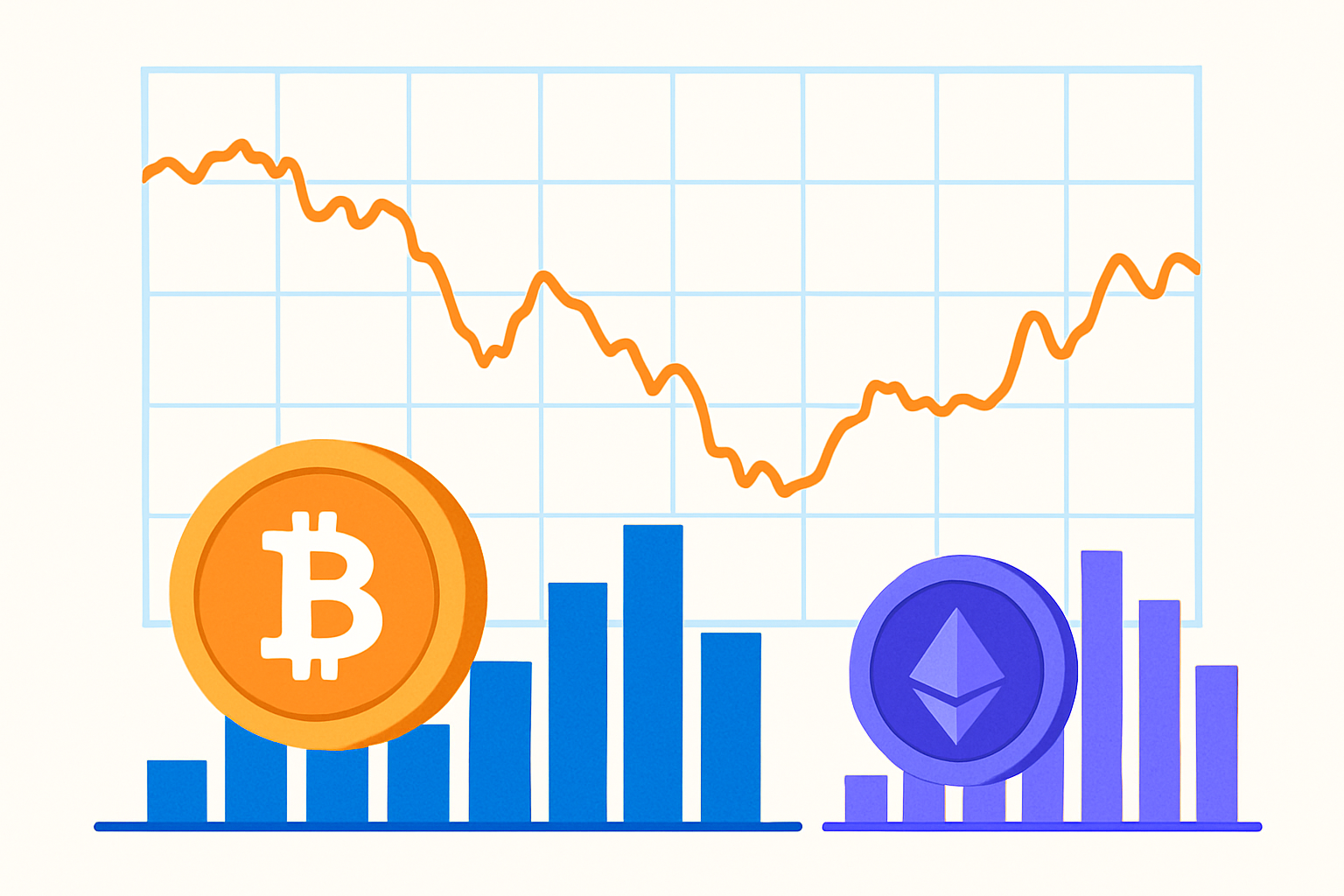How Bitcoin Dominance Trends Affect The Market?


Bitcoin dominance trends reveal what slice of the entire cryptocurrency pie Bitcoin's market capitalization takes up. Being the first and the heavyweight champ of digital assets, Bitcoin's dominance offers a clear snapshot of its standing in the crypto ecosystem and often hints at the overall market mood. When Bitcoin dominance climbs it usually signals investors are putting more faith in Bitcoin over altcoins. Conversely, when it dips it tends to point toward growing curiosity or a willingness to take bigger risks on alternative cryptocurrencies.
This article dives into how Bitcoin dominance trends usually ripple through the broader crypto market. It touches on how altcoins perform and shifts in investor risk appetite. It also covers the way market cycles unfold over time.
Understanding Bitcoin Dominance and How They Crunch the Numbers
Bitcoin dominance is calculated by taking Bitcoin's total market capitalization and dividing it by the entire cryptocurrency market capitalization at a given moment. Bitcoin’s market cap hitting $400 billion while the whole crypto market clocks in at $1 trillion gives us a Bitcoin dominance of 40%. This number has swung wildly. It started from over 90% in crypto's early days when Bitcoin was king of the castle and dropped to less than 40% as altcoins began stealing some of the spotlight. While this metric is a handy tool for getting a feel of market sentiment, it’s not without its quirks.
- Bitcoin dominance is basically a snapshot of Bitcoin's market capitalization as a slice of the whole cryptocurrency pie.
- You figure it out by dividing Bitcoin’s market cap by the total market caps of every crypto out there — altcoins and stablecoins included.
- Over the years this dominance number has danced around quite a bit. It soared past 90% when Bitcoin was the only game in town and dipped below 40% during the boom of altcoin mania.
- A bunch of factors play into these shifts. Token inflation, new altcoins flooding the scene and the growing stablecoin presence all tweak the dominance numbers.
- Some skeptics point out that Bitcoin dominance misses nuances like market depth, liquidity and subtle investor mood swings that can really move the needle.
Taking a Closer Look at Bitcoin Dominance and How It Plays Out in Market Cycles
Bitcoin dominance often paints a clear picture that aligns with the twists and turns of the crypto market like bull runs and bear markets. When the market is riding high and everyone is enthusiastic, Bitcoin dominance tends to dip as money flows into altcoins chasing bigger gains. Conversely, when things get uncertain, investors usually retreat to Bitcoin, boosting its dominance.
| Market Cycle | Approximate Bitcoin Dominance (%) | Altcoin Market Performance | Bitcoin Price Action |
|---|---|---|---|
| 2013 Bull Run | 95% | Altcoins were just starting to peek out, showing barely any hustle | Bitcoin rocketed from a modest $13 to a jaw-dropping $1,150, catching everyone off guard |
| 2017 Bull Run | 40-50% | Altcoins exploded onto the scene, fueled by the ICO frenzy frenzy, if you will | Bitcoin skyrocketed from about $1,000 to nearly $20,000, making dreamers dream bigger |
| Early 2018 Bear Market | 55-70% | Altcoins took a brutal hit, shedding more than 90% of their value — ouch | Bitcoin tumbled hard from its all-time high, reminding us all of the crypto rollercoaster |
| 2020-2021 DeFi Surge | 45-55% | DeFi and altcoins blossomed rapidly, turning heads and wallets alike | Bitcoin climbed steadily from roughly $7,000 to an eye-popping $64,000, a wild ride for sure |
| Mid 2022 to Present | 60-70%+ | The altcoin market noticeably tightened up, shrinking like a sweater in the wash | Bitcoin experienced some serious price corrections, keeping everyone on their toes |

This historical data visualization reveals that Bitcoin dominance usually climbs during periods of market uncertainty and downturns, as investors naturally gravitate towards the relative safety of Bitcoin's well-established reputation and liquidity. During those spirited bull markets fueled by speculation and fresh innovations—think the ICO frenzy in 2017 or the DeFi boom from 2020 to 2021—Bitcoin dominance tends to dip as funds flow into altcoins chasing those tantalizingly bigger returns.
Main Factors Influencing Shifts in Bitcoin Dominance
A few key factors steer the twists and turns of Bitcoin dominance. Investor choices often veer one way or another because of market mood. They balance Bitcoin's reputation as a safe haven with the thrill and gamble of altcoins. News about regulations hits altcoins harder and sparks jolts in dominance. When Bitcoin rolls out technological upgrades it usually perks up in appeal but new protocols can steal the spotlight.
- Market sentiment tends to be like a weather vane constantly shifting and causing rotations between Bitcoin’s solid reputation as a safe harbor and the shiny growth prospects altcoins offer.
- Regulatory changes aimed at either Bitcoin or altcoins can quickly shake up dominance by affecting investor confidence and sometimes leave everyone holding their breath.
- New altcoin projects and blockchain protocols often lure funds away from Bitcoin proving that shiny new things still catch the eye.
- Major technological upgrades to Bitcoin like Taproot genuinely boost its usefulness and can nudge its dominance upward.
- Large-scale economic events whether it’s climbing inflation or geopolitical drama tend to shake the global risk appetite and influence how much investors are willing to dive into crypto assets.
"> Bitcoin dominance doesn’t just highlight how rock-solid Bitcoin remains; it also offers a peek into the broader market’s mood and just how much risk investors are ready to shoulder. When sweeping economic trends collide with fresh innovations in the crypto space, these dominance patterns beautifully illustrate the ongoing tug-of-war between sticking to the tried-and-true and rolling the dice on something new. — Dr. Elena Martinez, Crypto Market Analyst"
Bitcoin Dominance as an Indicator of Market Sentiment
When it comes to gauging the mood of the crypto market, Bitcoin dominance often sneaks in as a surprisingly telling sign. Think of it as the bellwether, quietly signaling where investors' hearts (and wallets) are leaning. While it’s not the whole story, keeping an eye on Bitcoin’s share of the total crypto market cap can offer some valuable hints about whether people are flocking to safety or chasing the thrill of altcoins. In my experience, it’s a subtle yet savvy tool to read the market’s emotional temperature without getting overwhelmed.
Traders and investors often keep an eye on Bitcoin dominance as a mood ring for the market’s current vibe and risk appetite. When dominance climbs it usually signals growing caution and a flight toward Bitcoin’s well-earned reputation for reliability. Conversely, when you see dominance dip it tends to suggest a sunnier outlook and a bit of a hunger for bigger, flashier gains in altcoins.
Keep a close eye on rising Bitcoin dominance since it often acts as a canary in the coal mine, signaling growing market risk aversion and a natural shift toward Bitcoin.
Usually a sign that individuals are feeling adventurous and speculation is heating up.
This combo tends to paint a much clearer picture of just how powerful a market move really is.
Bitcoin dominance has its limits, so don’t put all your eggs in that basket when making investment decisions.
Mix dominance metrics with sentiment analysis and macroeconomic data to get a fuller, richer understanding of what’s really driving the market's twists and turns.
How Bitcoin Dominance Trends Subtly Shape Market Participants' Moves
Trends in Bitcoin dominance often set the tone for how different market players call the shots. Retail investors, institutions and traders usually have their own unique twists on reacting to shifts in dominance. They fine-tune their strategies based on what feels like risk or opportunity at the moment. For institutions dominance data tends to be a key ingredient in steering portfolio diversification and keeping risk in check. Retail traders on the other hand frequently lean on these trends to time their moves in and out of altcoin positions—trying to catch the wave just right.
- Retail investors often pull their funds out of altcoins and back into Bitcoin when its dominance starts to climb, usually seeking a bit more of a safe harbor.
- Institutional investors tend to tweak their crypto portfolios in line with dominance trends, aiming to strike a smarter balance between risk and potential gains.
- Traders switch up their game plans according to these dominance cycles, hopping between Bitcoin-centric trades and altcoin arbitrage opportunities like seasoned pros.
- Risk management techniques lean on dominance analysis as a handy tool to dial down exposure during those wild market swings we’ve all come to expect.
- Funding for ICOs and shiny new altcoin projects usually ebbs and flows with Bitcoin’s dominance, which can really steer the current of innovation in the space.
Case Studies Examining the Ups and Downs of Bitcoin Dominance and the Market Ripples They Create
Taking a closer look at those key moments when Bitcoin dominance shifted right alongside major market moves offers some pretty useful insights. These case studies highlight how changes in dominance often popped up just before or at the same time as notable price swings.
- Bitcoin's dominance took a noticeable nosedive as the altcoin boom kicked into high gear, fueling a frenzy of ICOs and sending altcoin prices skyrocketing.
- Liquidity and investor focus shifting rapidly between Bitcoin and an ever-growing list of DeFi protocols – it was quite the rollercoaster for those paying attention.
- Bitcoin dominance made a comeback during market downturns, revealing its role as the go-to safe haven amid a shaky economic backdrop and what many called the dreaded crypto winter.
Strategies for Navigating Market Changes Based on Dominance Trends
Investors and traders often lean on Bitcoin dominance trends to fine-tune their portfolio allocation and manage risk while trying to nail the timing just right. Keeping a keen eye on shifts in dominance and price movements helps them diversify smartly between Bitcoin and altcoins. They also set up alerts for key market signals and roll out hedging strategies to protect their capital when things get a little wild.
Keep a sharp eye on Bitcoin dominance along with Bitcoin and altcoin price moves—it’s like reading the room to get a better feel for where the market’s mood is headed.
Tweak your portfolio with care. Lean into Bitcoin when its dominance is rising and explore altcoins when that dominance dips.
Set up personalized alerts for noticeable shifts in dominance percentages. These early heads-ups can save you from surprises down the line.
Consider hedging strategies like moving into stablecoins or options to help shield yourself when dominance trends look iffy.
Keep your ear to the ground on macroeconomic news and fresh crypto signals. Staying in the loop helps you fine-tune your moves and stay in sync with the bigger market picture.
Start Your Crypto Journey with Coinbase Today
Ready to enter the cryptocurrency market but unsure where to begin? Coinbase makes buying, selling, and storing digital assets simple and secure for beginners and experts alike.








